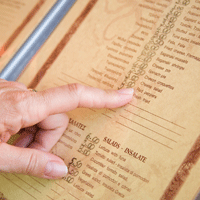It’s amazing how few restaurant operators capture the sales opportunities the menu offers. It’s too bad, because it’s a great selling tool that can be enhanced by suggestive selling and table-tent promotions. So, from a business standpoint, it’s best to convince your customers to purchase the most profitable items, using the least manpower. Below are tips on how to use the menu to increase profitability.
Adjust focus
Focus design decisions on the fact that the majority of the population is right-handed. For example, when given a single-fold menu, right-handed people tend to immediately look in the upper right-hand corner. They do the same with a two-fold menu, so it would be wise to place the high-profit items in the top right section of the menu.
Be strategic
In a list of 10 or more menu items, diners often only look at the first few items and/or the last few items. So, if you have a list of 10, the most profitable dishes should be the first, second and third items or the ninth and tenth items. A customer looking for a specific dish will find it.
Box it in
To emphasize dishes, enclose them in a box or highlight them to attract the customer’s eye. For example, a restaurateur may want to highlight desserts in a box so the diner can choose one before they order their entrée. Other items to consider boxing are low-cost items, such as pizza. Such boxing will provide higher visibility of high-contribution items, possibly encouraging diners to purchase them over more expensive and less profitable menu options.
Promote specials
The Chef’s Special or Special of the Day is a creative way to reuse leftovers or generate sales of items that provide a high contribution to profit. In either case, people want to know the daily specials and may order one because they think it’s fresh or a one-time offer. The ‘special’ should be an item that yields a high contribution and does not take a lot of effort to implement. It should not be the house specialty that might have a smaller margin.
Have your say
Opening and closing statements cost nothing and encourage communication. An opening statement should be a simple, stand-alone note on the front cover or top of the first page of the menu. It may read: “Thank you for joining us. Our objective is to provide a unique dining and foodservice experience. Our fruits and vegetables are locally grown; our meats are prime cuts; our fish are flown in fresh daily and our breads and desserts are baked daily using the finest ingredients. We hope you enjoy dining with us.” It should be signed by the management or owners. A closing statement is usually found at the back of the menu (or in the check folder). It might read: “We hope you enjoyed your dining experience. We appreciate constructive customer feedback and welcome yours. Thank you for allowing us to serve you this evening — it was our pleasure. We hope to see you again soon.”
Show value
Value statements are a bit of a con, but they can add punch to a menu. These statements are often used at quick-service restaurants that offer a value menu with more options for less money. Another approach forgoes the discount but shows value. For example, an offer of two eggs, bacon and home fries can be sold for $3.99 with a fair food cost of 30 per cent or it can be offered at $3.99, with the tag line that points out the meal has a $5 value.
Adjust size and clarity
Many people have trouble reading menus with small print and lots of design — especially in dim lighting. To make the dining experience memorable, try the following: create contrast by using black on white or black on beige paper; increase the print size; or build loyalty by buying a half dozen pairs of cheap magnifying glasses of varying strengths for customers. And, consider providing small flashlights or a portable desk light that can be brought table-side to enhance the customer experience.
Before you know it, you’ll be able to tighten up the menu and record noticeable results.
Douglas P. Fisher is a foodservice and franchise consulting practitioner, with a practice focused on franchise development, operations assessment and litigation support. In business since 1984, Fisher is the author of four industry-related books, including Canadian Restaurant Accounting, the national accounting standards published by the CRFA as well as The Bottom Line report, produced jointly with F&H and Ryerson University. He can be reached at [email protected]. For more information, visit fhgi.com.
Keep Reading
Hospitality Market Report 2012: Slow and Steady
New Food Display Concepts Provide Diverse Functionality
Key Opportunities To Attract Holiday Diners




![Redberry Restaurants Becomes Canada’s Area Director for Jersey Mike’s Subs Expansion Redberry Jersey Mike’s Subs - Paul Pascal (left), director of Operations, and Stephen Scarrow (right), senior Marketing manager]](https://www.foodserviceandhospitality.com/wp-content/uploads/2024/04/Redberry-Appointments-218x150.jpg)
















